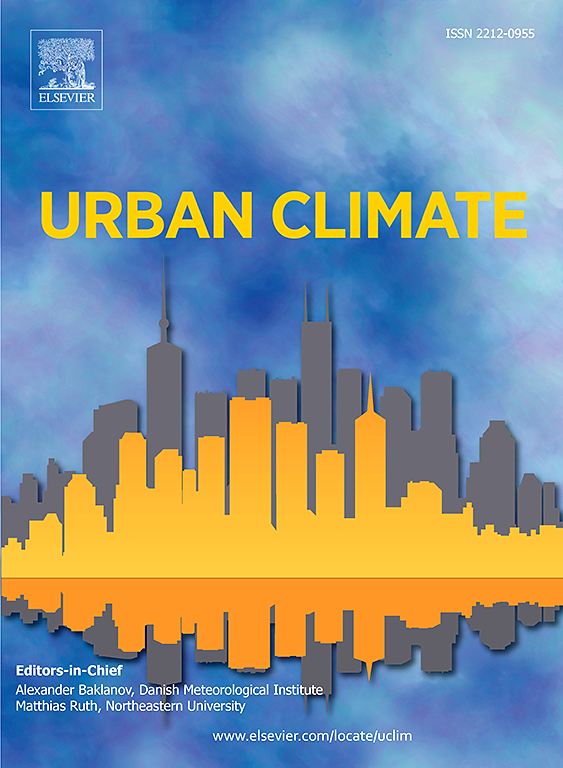Variability of greenhouse gases in Lagos: CO2, CH4, N2O and halocarbons in a developing Western Africa megacity
IF 6
2区 工程技术
Q1 ENVIRONMENTAL SCIENCES
引用次数: 0
Abstract
Greenhouse gas (GHG) emissions significantly affect climate change, public health, and the environment. Lagos, a developing megacity with a bustling economy and growing population, contributes substantially to GHG concentrations through intensive energy consumption and material use. This study investigated the temporal and spatial distributions of key ambient GHGs across Lagos, Nigeria, from August 2020 to July 2021, including carbon dioxide (CO₂), nitrous oxide (N₂O), methane (CH₄), and halocarbons (chlorofluorocarbons, hydrochlorofluorocarbons, and hydrofluorocarbons). Using data from a network of six sampling stations, the relationships among these GHGs and their concentrations in relation to urban emissions were analyzed. Our findings identified distinct seasonal variability in GHG concentrations driven by urban activities and meteorological conditions. CO₂ concentrations ranged from 455 to 484 ppmv, with peak values at the IKO and NCF stations. CH₄ concentrations reached a maximum of 2210 ppbv, primarily attributed to waste management activities, while N₂O showed minimal variations suggesting limited local sources. Halocarbon concentrations peaked during the dry season due to increased air conditioning use and industrial activities. Alternatively, CO₂, N₂O, and CH₄ were highest during the wet season (April to July), influenced by increased vehicular emissions and enhanced waste decomposition in waterlogged landfills. The study identified transportation, waste management, and refrigeration as the primary GHG sources in Lagos. The observed correlations between halocarbons and other GHGs underscore the interconnected nature of urban emissions sources. These findings provide valuable insights for policymakers and stakeholders to develop targeted mitigation strategies for reducing GHG emissions in rapidly urbanizing megacities.
拉各斯温室气体的变异性:西非一个发展中的特大城市的CO2、CH4、N2O和卤代烃
温室气体(GHG)排放对气候变化、公众健康和环境产生重大影响。拉各斯是一个发展中的特大城市,经济繁荣,人口不断增长,通过密集的能源消耗和材料使用,大大增加了温室气体浓度。本研究调查了2020年8月至2021年7月尼日利亚拉各斯主要环境温室气体的时空分布,包括二氧化碳(CO₂)、氧化亚氮(N₂O)、甲烷(CH₄)和卤代烃(氯氟烃、氢氯氟烃和氢氟烃)。利用由6个采样站组成的网络数据,分析了这些温室气体及其浓度与城市排放的关系。我们的研究发现,在城市活动和气象条件的驱动下,温室气体浓度存在明显的季节变化。CO₂浓度范围为455 ~ 484 ppmv,峰值在IKO和NCF站。nh4浓度最高达到2210 ppbv,主要归因于废物管理活动,而N₂O的变化很小,表明当地来源有限。由于空调使用和工业活动的增加,卤代烃浓度在旱季达到峰值。另外,CO₂,N₂O和CH₄在雨季(4月至7月)最高,受车辆排放增加和淹水填埋场废物分解增强的影响。该研究确定运输、废物管理和制冷是拉各斯的主要温室气体来源。观测到的卤代烃与其他温室气体之间的相关性强调了城市排放源的相互关联性质。这些发现为决策者和利益攸关方制定有针对性的缓解战略,以减少快速城市化的特大城市的温室气体排放提供了宝贵的见解。
本文章由计算机程序翻译,如有差异,请以英文原文为准。
求助全文
约1分钟内获得全文
求助全文
来源期刊

Urban Climate
Social Sciences-Urban Studies
CiteScore
9.70
自引率
9.40%
发文量
286
期刊介绍:
Urban Climate serves the scientific and decision making communities with the publication of research on theory, science and applications relevant to understanding urban climatic conditions and change in relation to their geography and to demographic, socioeconomic, institutional, technological and environmental dynamics and global change. Targeted towards both disciplinary and interdisciplinary audiences, this journal publishes original research papers, comprehensive review articles, book reviews, and short communications on topics including, but not limited to, the following:
Urban meteorology and climate[...]
Urban environmental pollution[...]
Adaptation to global change[...]
Urban economic and social issues[...]
Research Approaches[...]
 求助内容:
求助内容: 应助结果提醒方式:
应助结果提醒方式:


